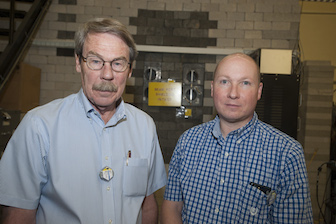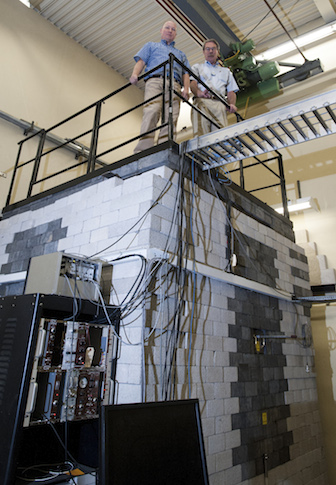New nuclear science grants propel Idaho State University into top tier in nuclear materials in the United States
September 12, 2014
Using new grant funding, Idaho State University researchers are working to create accurate reactor physics benchmarks that will help ensure the safe operation of nuclear reactors, a critical component in our energy future.
These grants also enable ISU nuclear researchers to study nuclear fuel materials and how they perform over time. This research is aimed at improving the life span and stability of these fuels.
ISU has received three new grants this fiscal year worth more than $600,000 in total, from the U.S. Department of Energy Nuclear Energy University Programs.
 “These new funds build on a tradition of excellence in nuclear materials at ISU,” said Howard Grimes, ISU vice president for research and economic development. “We are leveraging our research expertise with the Idaho National Laboratory to assist our state in becoming a preeminent center for excellence in nuclear materials, science, and engineering. This is in alignment with the vision being created by Gov. Otter’s Leadership in Nuclear Engineering commission.”
“These new funds build on a tradition of excellence in nuclear materials at ISU,” said Howard Grimes, ISU vice president for research and economic development. “We are leveraging our research expertise with the Idaho National Laboratory to assist our state in becoming a preeminent center for excellence in nuclear materials, science, and engineering. This is in alignment with the vision being created by Gov. Otter’s Leadership in Nuclear Engineering commission.”
Grimes is a member of the LINE commission.
One of them is a $400,000 grant to ISU nuclear science Assistant Professor Chad Pope.
“We use computer models to predict how reactors behave, but the primary way we can trust those models is to compare them to real reactor performance,” Pope said. “We will define the exact dimensions and parameters for this reactor and configuration, and then we’ll build models to show that we can get correct results that match reality.”
Pope is using experimental data obtained from the EBR-II nuclear reactor, located at the Idaho National Laboratory.
“Our results will be included in the International Handbook of Evaluated Reactor Physics Benchmark Experiments, so designers will use this information as they advance their new simulation techniques,” Pope said. “The work I do today will be important to designers over the next several decades. Developers around the world interested in fast –reactor design will be able to use our benchmarks to build their codes.”
 Two doctoral and one master’s student will be working with Pope on the benchmarking project.
Two doctoral and one master’s student will be working with Pope on the benchmarking project.
The three NEUP grants received by ISU this fiscal year are a portion of the $10.4 million in grants that the ISU Department of Nuclear Engineering and Health Physics has pulled in since the beginning of fiscal year 2012.
“Receiving these NEUP grants is more evidence that ISU has one of the best nuclear science and health physics departments in the country,” said Richard Brey, dean of the ISU College of Science and Engineering. “These particular grants are very much in line with our college’s strategic plan. We’re focusing on nuclear science and engineering as one of our major areas we do well and is a strength, and we want to continue to enhance.”
The two other NEUP grants received in 2014 will both use ISU’s Nuclear Engineering Laboratory, which includes the AGN-201, a self-contained, graphite-moderated research and training reactor that is licensed to operate at a maximum thermal power of 5 watts. It consists of two basic units, the reactor unit and the control console. The ISU facility is one of only 25 experimental nuclear reactors on college campuses in the United States.
Pope has received a $91,000 grant for infrastructure improvement to the reactor laboratory.
“The laboratory allows us to attract high-quality students and perform important research,” Pope said. “It will provide us with instruments and supporting components to upgrade the facility. The neutron detectors that come with this grant will help us do higher quality research.”
George Imel, ISU professor of nuclear engineering and health physics, will be using the reactor laboratory as part of a $3 million grant to the University of Wisconsin and collaborators to test innovative ways to image nuclear fuel behavior to improve the safety of nuclear reactors and help prevent accidents in the future. Imel and an ISU doctoral student will begin their study on campus and then move their efforts to Kansas State University to use their transient reactor.
“We will be evaluating methods to determine what is happening inside of nuclear fuel as it is disrupted, when there is transient overpowering, too much power in a fuel, and what happens when there is under cooling,” Imel said. “It will be ground-breaking research.”
Categories:
